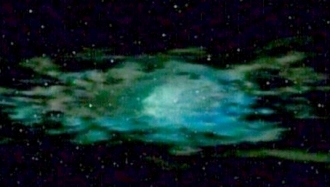
In Star Trek, a distortion ring (also called a spatial distortion wave) is a spatial anomaly where the shape of space-time itself is changing. In the Star Trek Voyager episode "Twisted", the USS Voyager was caught by a moving distortion ring, which collapsed its warp field and enveloped the ship. Most of the crew were trapped in various sections of the ship, unable to reach most systems as the spatial distortions continuously reconfigured the vessel's interior. Based on tricorder data, it seemed that the ship was also slowly being crushed by a spatial implosion.

A
distrtion ring, as depicted in 'Twisted'
It is not just black holes that warp space-time. Again, according to Einstein's general relativity, the Earth itself warps space-time. Accordingly, there is a greater change in spin direction, which is now called the geodetic effect, and also obeys the gyroscope's motion through the spacetime curvature. The geodetic effect represents the effect of the curvature of space-time on a spinning, moving body. This effect was detected in 1988 through lunar ranging and radio interferometry data gathering. The geodetic effect was verified in 2007 by the Gravity Probe B, an experiment which measures the tilting of the spin axis of gyroscopes in orbit about the Earth


Frame dragging around a black hole

I